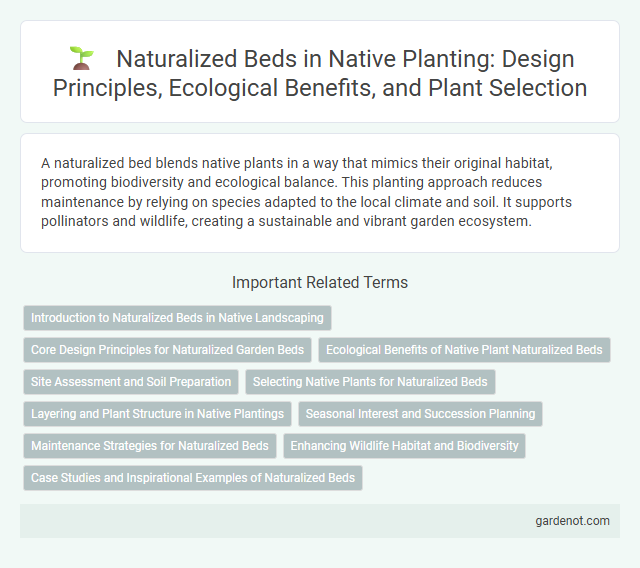A naturalized bed blends native plants in a way that mimics their original habitat, promoting biodiversity and ecological balance. This planting approach reduces maintenance by relying on species adapted to the local climate and soil. It supports pollinators and wildlife, creating a sustainable and vibrant garden ecosystem.
Introduction to Naturalized Beds in Native Landscaping
Naturalized beds in native landscaping mimic local ecosystems by using indigenous plants that require minimal maintenance and enhance biodiversity. These beds promote sustainable gardening by supporting pollinators, improving soil health, and conserving water through deep-rooted perennials and grasses. Integrating native species in naturalized beds creates resilient landscapes that adapt to regional climate and soil conditions, reducing the need for fertilizers and pesticides.
Core Design Principles for Naturalized Garden Beds
Naturalized garden beds emphasize biodiversity through layering native plants of various heights and root structures, fostering resilience and habitat creation. Incorporating a mix of grasses, wildflowers, and shrubs tailored to local soil and climate conditions promotes soil health and water conservation. Strategic placement avoids monocultures, ensuring year-round visual interest and supporting pollinators and wildlife.
Ecological Benefits of Native Plant Naturalized Beds
Native plant naturalized beds support local biodiversity by providing habitat and food sources for pollinators, birds, and beneficial insects. These beds enhance soil health through improved nutrient cycling and reduced erosion, fostering resilient ecosystems. Water conservation is promoted by native plants' deep root systems, which increase infiltration and reduce runoff.
Site Assessment and Soil Preparation
Effective site assessment for a naturalized bed includes analyzing soil pH, nutrient levels, drainage patterns, and sunlight exposure to ensure optimal plant growth. Soil preparation involves removing invasive species, loosening compacted soil, and incorporating organic matter such as compost to enhance fertility and structure. Accurate evaluation and tailored soil amendments support the establishment of native plants adapted to local conditions.
Selecting Native Plants for Naturalized Beds
Selecting native plants for naturalized beds involves choosing species adapted to local soil, climate, and ecosystem conditions, which promotes biodiversity and reduces maintenance. Prioritize a mix of grasses, perennials, and shrubs that provide seasonal interest, support pollinators, and improve soil health. Incorporating drought-tolerant and disease-resistant plants enhances resilience and ensures a sustainable, low-resource landscape.
Layering and Plant Structure in Native Plantings
Naturalized beds in native plantings emphasize layering through diverse vertical plant structures, including groundcovers, herbaceous perennials, shrubs, and canopy trees to create a dynamic habitat. This stratification mimics natural ecosystems, enhancing biodiversity and promoting ecological balance by supporting various wildlife species. Effective layering improves soil health, reduces erosion, and fosters resilience against pests and climate variations.
Seasonal Interest and Succession Planning
Naturalized beds offer dynamic seasonal interest by showcasing a variety of native plants that bloom, fruit, and change foliage color throughout the year. Succession planting ensures continuous visual appeal and ecological benefits by strategically selecting species that thrive in different seasons, supporting pollinators and wildlife. Designing with native grasses, wildflowers, and shrubs in succession maximizes biodiversity and creates a resilient, self-sustaining naturalized landscape.
Maintenance Strategies for Naturalized Beds
Effective maintenance strategies for naturalized beds include regular monitoring of plant health and controlling invasive species to preserve native biodiversity. Mulching with organic materials helps retain soil moisture and suppresses weed growth, supporting sustainable plant development. Seasonal pruning and selective thinning promote air circulation and enhance the natural aesthetics of the native planting area.
Enhancing Wildlife Habitat and Biodiversity
Naturalized beds utilize native plants to create diverse, self-sustaining ecosystems that provide essential food and shelter for local wildlife such as pollinators, birds, and small mammals. These habitats improve biodiversity by supporting a wide variety of species and promoting ecological balance through natural plant succession and soil health. Strategic selection of native perennials, grasses, and shrubs encourages native pollinator populations and enhances regional wildlife corridors.
Case Studies and Inspirational Examples of Naturalized Beds
Naturalized beds showcase diverse native planting projects that restore ecosystems and enhance biodiversity by mimicking natural habitats. Case studies highlight successful designs using local wildflowers, grasses, and shrubs, demonstrating resilience and low maintenance in various climates. Inspirational examples include restored prairie landscapes and urban green spaces that support pollinators and improve soil health through native species integration.
Naturalized bed Infographic

 gardenot.com
gardenot.com